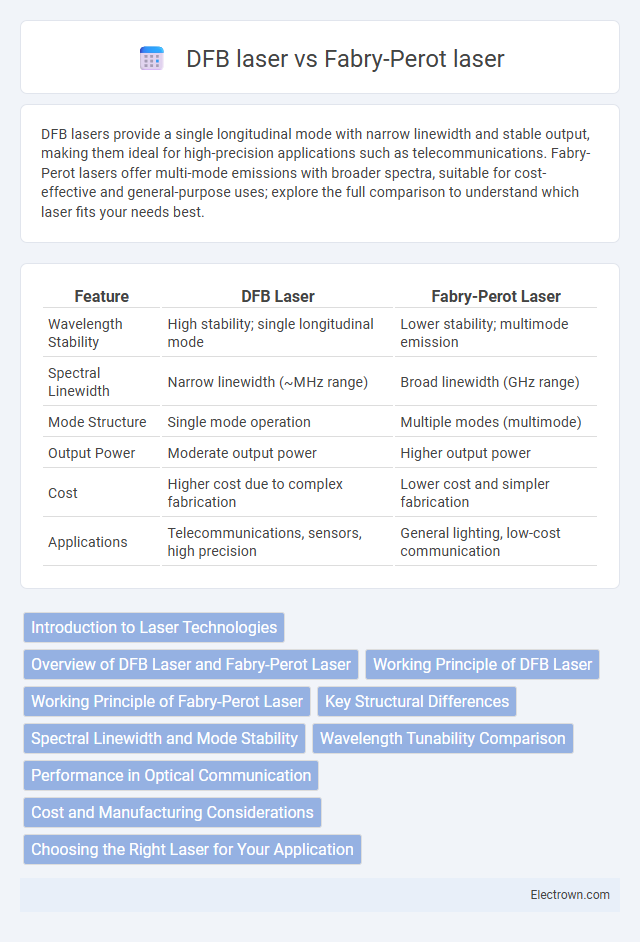DFB lasers provide a single longitudinal mode with narrow linewidth and stable output, making them ideal for high-precision applications such as telecommunications. Fabry-Perot lasers offer multi-mode emissions with broader spectra, suitable for cost-effective and general-purpose uses; explore the full comparison to understand which laser fits your needs best.
Table of Comparison
| Feature | DFB Laser | Fabry-Perot Laser |
|---|---|---|
| Wavelength Stability | High stability; single longitudinal mode | Lower stability; multimode emission |
| Spectral Linewidth | Narrow linewidth (~MHz range) | Broad linewidth (GHz range) |
| Mode Structure | Single mode operation | Multiple modes (multimode) |
| Output Power | Moderate output power | Higher output power |
| Cost | Higher cost due to complex fabrication | Lower cost and simpler fabrication |
| Applications | Telecommunications, sensors, high precision | General lighting, low-cost communication |
Introduction to Laser Technologies
Distributed Feedback (DFB) lasers utilize a built-in grating structure to provide wavelength-selective feedback, enabling single-mode operation with narrow spectral linewidth, crucial for high-speed optical communication systems. Fabry-Perot (FP) lasers, characterized by their parallel reflective facets, emit multiple longitudinal modes with broader spectral output, making them suitable for cost-sensitive applications where low coherence is acceptable. The precise wavelength control of DFB lasers enhances data transmission stability, while FP lasers offer simpler design and lower manufacturing costs for short-reach communication links.
Overview of DFB Laser and Fabry-Perot Laser
DFB lasers feature a distributed Bragg reflector grating within the laser cavity that ensures single-mode emission and narrow linewidth, making them ideal for high-precision applications such as telecommunications and sensing. Fabry-Perot lasers rely on reflective cavity facets to form the resonant cavity, resulting in multiple longitudinal modes and broader spectral output suited for general-purpose lighting and simpler optical systems. Your choice between a DFB laser and Fabry-Perot laser depends on the required spectral purity, output stability, and application-specific performance needs.
Working Principle of DFB Laser
Distributed Feedback (DFB) lasers utilize a built-in diffraction grating within the active region to provide wavelength-selective feedback, allowing single-mode operation with stable, narrow linewidth emission. Unlike Fabry-Perot lasers, which rely on cleaved facets for cavity feedback and produce multiple longitudinal modes, DFB lasers achieve precise wavelength control due to their periodic grating structure that enforces constructive interference at a specific wavelength. Your communication systems benefit from the DFB laser's ability to deliver consistent intensity and spectral purity, critical in high-speed optical fiber transmission.
Working Principle of Fabry-Perot Laser
The Fabry-Perot laser operates using a pair of parallel mirrors that form an optical cavity, allowing multiple longitudinal modes to resonate within the laser medium. Its emission spectrum consists of multiple wavelengths due to the broad gain profile and the cavity length, resulting in multimode output. This simple structure contrasts with the distributed feedback (DFB) laser, which uses a diffraction grating for single-mode operation.
Key Structural Differences
DFB lasers feature a built-in grating structure within the semiconductor material, providing single-mode operation with narrow linewidth and stable wavelength. Fabry-Perot lasers rely on parallel cleaved facets as reflectors, resulting in multi-mode output and broader spectral width. Understanding these key structural differences helps optimize your laser choice for specific applications requiring precision or power.
Spectral Linewidth and Mode Stability
DFB lasers offer significantly narrower spectral linewidths, typically in the range of a few MHz, compared to Fabry-Perot lasers which exhibit broader linewidths often exceeding hundreds of MHz. The distributed feedback structure in DFB lasers ensures single longitudinal mode operation, enhancing mode stability and reducing mode hopping under varying temperature and current conditions. Your optical communication system benefits from improved coherence and reduced signal distortion when utilizing DFB lasers over Fabry-Perot lasers.
Wavelength Tunability Comparison
DFB lasers offer superior wavelength tunability compared to Fabry-Perot lasers due to their grating structure that stabilizes emission at a specific wavelength with minimal side modes. Fabry-Perot lasers exhibit broader wavelength spectra but suffer from mode hopping and less precise tuning control. For applications requiring narrow linewidth and stable wavelength, such as high-speed optical communication, DFB lasers are typically preferred over Fabry-Perot lasers.
Performance in Optical Communication
DFB lasers offer superior spectral purity and narrower linewidth, enabling higher data transmission rates and longer reach in optical communication systems compared to Fabry-Perot lasers. Their single longitudinal mode operation minimizes mode hopping and reduces signal distortion, enhancing signal integrity over fiber links. Fabry-Perot lasers exhibit broader emission spectra and multi-mode behavior, leading to increased dispersion and limited bandwidth performance in high-speed optical networks.
Cost and Manufacturing Considerations
DFB lasers typically have higher manufacturing costs due to more complex fabrication processes involving precise grating structures, while Fabry-Perot lasers are simpler and cheaper to produce. The cost difference influences your choice in applications where budget constraints favor Fabry-Perot lasers, but performance stability is critical in DFB lasers. Mass production of Fabry-Perot lasers benefits from established, cost-effective methods, making them ideal for high-volume, low-cost markets.
Choosing the Right Laser for Your Application
Selecting between a DFB laser and a Fabry-Perot laser depends on the application's required spectral purity and stability. DFB lasers offer single-mode emission with narrow linewidth and high wavelength stability, making them ideal for high-speed optical communication and sensing. Fabry-Perot lasers provide multi-mode output and lower cost, suitable for short-distance data transmission and cost-sensitive applications where spectral precision is less critical.
DFB laser vs Fabry-Perot laser Infographic

 electrown.com
electrown.com